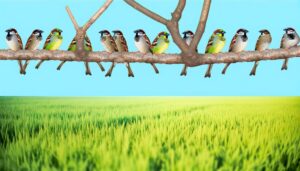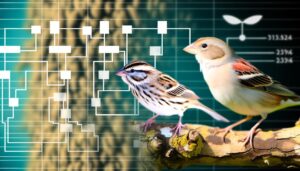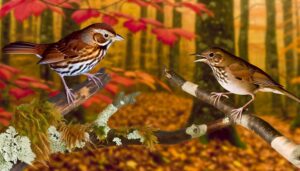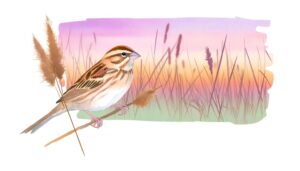10 Tips to Attract Tree Sparrows to Your Garden
To attract Tree Sparrows, one must cater to their specific needs. Providing a variety of food sources like small seeds, insects, and fruits, especially during different seasons, is essential.
They need quiet nesting areas with dense shrub cover, near food sources and water. Their nests are typically 1.5 to 2.5 meters off the ground, constructed with grass, straw, feathers, and moss.
Minimizing disturbances and maintaining predator barriers enhance their safety. Ensuring a consistent food supply and practicing organic gardening can make the environment more welcoming.
Discover more about creating a safe habitat by carrying on along this information trail.
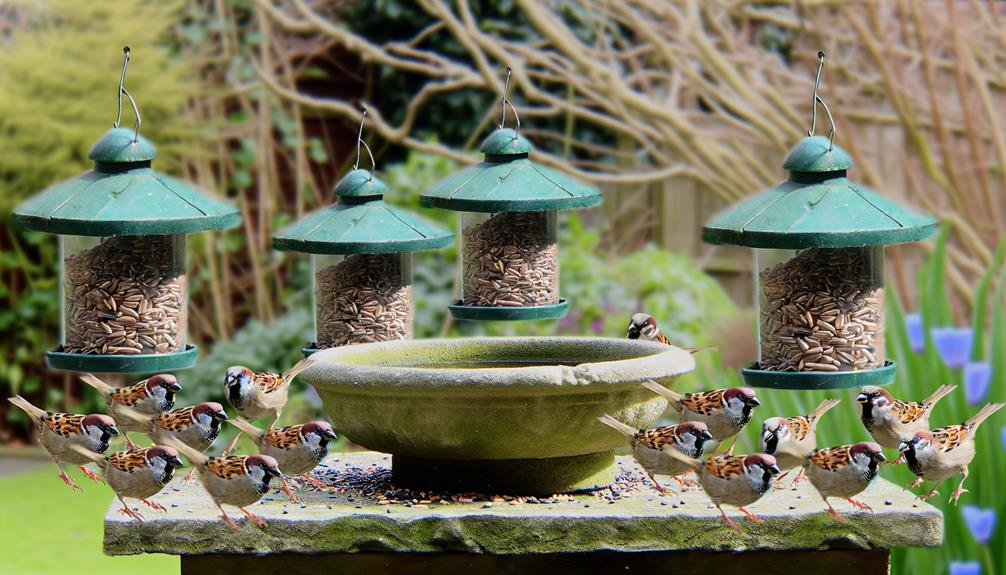
Key Takeaways
- Provide a variety of food such as millet, black oil sunflower seeds, insects, and fruits or berries especially in winter.
- Create safe nesting areas 1.5 to 2.5 meters off the ground, preferably near water and food sources, and in quiet, covered locations.
- Install dense shrubs for shelter, and use predator barriers to protect the sparrows from potential threats.
- Maintain a clean environment by regularly cleaning bird feeders to prevent diseases and practicing organic gardening.
- Minimize human disturbance near their habitat and ensure a consistent supply of food and water.
Understanding Tree Sparrow Basics
To attract Tree Sparrows effectively, one must first grasp the fundamental characteristics, behaviors, and needs of these fascinating birds. Tree Sparrows, scientifically known as Passer montanus, are unique avian species, differing from their House Sparrow cousins. They're smaller, with a chestnut brown head and nape, and distinctive black cheek spots.
Typically, they're found in rural and semi-urban areas, often nesting in hedgerows, shrubs, or trees. They're known for their social behavior, often seen in flocks, and they're not migratory. Understanding their preferred habitats is crucial. They require dense cover for nesting and protection from predators.
Tree Sparrows are in decline, so creating a bird-friendly environment can help conserve this species. It's crucial to avoid disturbing their habitats to safeguard their protection and preservation.
Preferred Sparrow Feeding Habits
Understanding the preferred feeding habits of tree sparrows is essential for attracting these birds effectively.
A thorough analysis of sparrow dietary preferences reveals the specific food items that are most likely to entice them.
In addition, strategic feeder placement also plays a significant role, which requires a detailed understanding of the sparrow's environmental and spatial preferences.
Sparrow Dietary Preferences
Examining the dietary preferences of tree sparrows is essential, as these birds have a strong preference for seeds, particularly those of grasses and weeds, yet they won't turn down a tasty insect or caterpillar during the breeding season. Understanding that their diet varies seasonally helps determine what to offer in feeders, optimizing the attraction strategy.
In winter, sparrows consume more seeds, gravitating towards millet and sunflower seeds. Their beaks, designed for seed cracking, make these a preferred choice. During spring and summer, when breeding, their diet shifts to protein-rich food like insects, providing essential nutrients for offspring development.
Hence, a mix of seeds and insect larvae throughout the year caters to their dietary changes and can effectively attract sparrows.
Feeder Placement Strategies
Implementing strategic feeder placement plays an important role in attracting tree sparrows, as these birds exhibit certain feeding habits and preferences that should be taken into account. By understanding their feeding patterns and preferences, one can optimize their feeder placement to attract more sparrows.
Feeder placement strategies should consider:
- Location: Tree sparrows prefer feeders that are near shrubs or trees for protection.
- Height: Generally, feeders should be hung at a height of about 4-5 feet.
- Distance from windows: To prevent collisions, feeders should be placed at least 10 feet away from windows.
- Quiet areas: Sparrows prefer feeders located in quieter, less frequented areas.
- Sunlight exposure: Sparrows are attracted to feeders with good sunlight exposure.
Following these strategies will greatly improve the chances of attracting tree sparrows.
Top Tree Sparrow Attracting Foods
Several types of food have proven to be irresistible to Tree Sparrows, making them an ideal choice for those aiming to attract these birds. First, they're partial to small seeds. Millet, both white proso and red, is a particular favorite. However, they also consume black oil sunflower seeds, though less frequently.
Insects form a significant portion of their diet, particularly during breeding season. Aphids, beetles, and caterpillars are among their preferred choices.
Lastly, Tree Sparrows are known to eat fruits and berries, especially during winter. Apples, sultanas, and raisins can be left out to attract them.
It's important to note that while these foods appeal to the Sparrows, they shouldn't replace natural forage entirely. They're best used as supplements to a naturally occurring food source.
Essential Nesting Requirements
To optimize the chances of attracting Tree Sparrows, understanding their essential nesting requirements is crucial.
The focus should be on two main factors: ideal nesting locations and sparrow-friendly building materials.
A detailed discussion on these elements will provide a thorough guide to creating an attractive and suitable environment for these birds.
Ideal Nesting Locations
Understanding the specific nesting requirements of Tree Sparrows can greatly enhance your ability to attract these birds to your garden or backyard.
Ideal locations for Tree Sparrows' nests should cater to their very specific preferences:
- Tree Sparrows prefer nesting sites that are elevated, usually choosing spots that are between 1.5 to 2.5 meters off the ground.
- They opt for areas with a good balance of coverage and visibility.
- Nesting sites near a water source are highly favored.
- They prefer locations that are quiet and undisturbed by human activity.
- Proximity to food sources is also a significant factor in their nesting site selection.
Understanding and catering to these preferences can increase your success in attracting Tree Sparrows to nest in your garden or backyard.
Sparrow-Friendly Building Materials
Once you've identified an ideal location for a Tree Sparrow's nest, the next step is to provide the appropriate building materials they need for nest construction.
Tree Sparrows, like most bird species, have specific preferences for nesting materials. These include grass, straw, and leaves, which they use to create the nest's base. For the lining, feathers, moss, and animal hair are preferred for their softness and insulating properties.
Remember, offering these materials in a safe, accessible manner is crucial. You can, for instance, leave them in a feeder or scatter them near the chosen nesting site.
Using these sparrow-friendly materials not only supports the birds' nesting process but also enhances their survival rates, contributing to the overall well-being and sustainability of the species.
Creating a Sparrow-Friendly Environment
Creating an inviting habitat for tree sparrows requires careful consideration and strategic planning, focusing on aspects such as food sources, nesting options, and safety from predators. It's not enough to simply provide food and hope for the best. Instead, consider the following key elements:
- Food Variety: Offer a mix of seeds, insects, and fruits, catering to the diverse diet of sparrows.
- Nesting Sites: Make sure nesting boxes are in quiet, undisturbed areas.
- Cover: Dense shrubs provide important shelter and escape routes.
- Predator Protection: Install barriers to deter common predators like cats and squirrels.
- Minimal Human Interaction: Sparrows prefer environments with limited human disturbance.
These factors, when combined, create an environment conducive to supporting a thriving sparrow population.
The Importance of Water Sources
In addition to creating a sparrow-friendly environment, providing a dependable water source plays a significant role in attracting and supporting tree sparrows. These birds need water for drinking and bathing. Without it, their survival is at risk, and they're less likely to inhabit a given area.
| Aspect | Importance | Solution |
|---|---|---|
| Drinking Water | Essential for hydration and digestion | Offer a shallow bird bath or dish |
| Bathing Water | Key for feather maintenance and parasite control | Guarantee water source allows for bathing |
| Reliability | Consistency leads to habitual visits | Regularly refill and clean water sources |
Note that the water source should be shallow to prevent drowning and placed in a quiet, yet visible spot. Regular cleaning prevents disease spread. Therefore, a well-maintained water source forms an important part of a tree sparrow's habitat.
Addressing Potential Threats for Sparrows
Exploring the dangers that hide in a sparrow's environment is crucial for their survival and overall well-being. It's important to address these potential threats, taking appropriate steps to guarantee a safe habitation.
- Predators: Cats, birds of prey, and snakes are primary threats. Removing potential hiding areas for these predators can help.
- Disease: Regular cleaning of feeders and baths reduces disease spread.
- Pesticides: Avoid using harmful chemicals in gardens where sparrows feed.
- Windows: Birds often collide with windows. Use bird-friendly window treatments to prevent this.
- Starvation: Sparrows rely on seeds and insects. Ensure a year-round supply of food.
Conclusion
Attracting tree sparrows is akin to conducting a symphony. It requires understanding their needs, including food preferences, nesting essentials, and the need for a sparrow-friendly environment.
Water sources play a vital role, like the rhythm in our melody.
Finally, addressing potential threats, the discordant notes, secures their survival.
By harmonizing these elements, one can create a backyard sanctuary that resonates with the beautiful song of tree sparrows.

